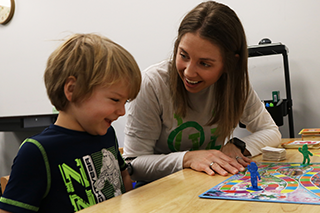Transitioning to Solids
Transitioning your child from a bottle to cups and introducing solid foods can be a fun and exciting journey for both parent and child. The American Academy of Pediatrics recommends children be introduced to foods other than breast milk/formula when they are six months old. Here are some handy tips and recommended products from our expert speech-language pathologists to make mealtime a breeze:
Cups
Encourage the use of both straw and open cups to promote versatility and independence. Cups with handles can aid in developing grip strength.
Ezpz Mini Cup: Perfect for little hands, this cup is easy to hold and encourages independence.
Lollacup: With its weighted straw design, the Lollacup helps little ones drink comfortably and confidently.
NumNum Weighted Straw Training Cup: Ideal for transitioning to straw use, this cup helps develop sipping skills.
Plates
Using a tray with molded sections to help introducing foods to
your child can be a good way to set mealtime routines and encourage tactile
exploration by letting them explore a variety of textures. It can be messy –
but a great way to acquaint your kiddo with different types of food.
When
presenting pureed solids, try placing some directly on the child’s tray for
them to dig into and try. Have some puree in a bowl for you to feed your child
as well. When transitioning to use of a plate, we recommend non-skid silicone
plates with built-in placemats to help keep the plate on the table/tray and
avoid plates being thrown/tipped over.
Ezpz Happy Mat: This non-skid silicone plate with a built-in placemat keeps plates in place, preventing spills and messes.
Spoons
When your child begins to show interest in using utensils, start
with a spoon as it’s easier to use for actions like dipping. We suggest having
more than one spoon on hand to at mealtimes to avoid power struggles. Preload a
spoon for your child to explore with while you use another for feeding.
Ezpz Tiny Spoon, Nuby’s Baby’s First Spoon, Dr. Brown’s Soft Tip Spoon: These spoons are designed with smaller sizes and flat bowls, perfect for little mouths and easy food removal.
General Tips
- Supervision: Always supervise your child during mealtimes and ensure they are seated in an appropriate high chair.
- Variety: Introduce a variety of textures and foods to expand your child’s palate.
- Embrace Mess: Allow your child to explore food textures and be messy during meals.
- Reflexes: Don’t panic if your child gags on new textures; it’s a natural defense mechanism against choking.
- Persistence: Keep offering foods even if your child rejects them initially. Preferences can change over time.
- Positive Atmosphere: Stay positive during mealtimes and follow your child’s cues. Mealtime doesn’t need to be rigid; end on a positive note.
With the right tools and approach, mealtime can be an enjoyable experience for both you and your little one. Happy eating!
Featured Experts
CP's speech-language pathologists take a collaborative approach to care to work for every child we treat. From mild developmental delays to medically complex cases, our team is experienced and equipped to help your child meet their goals. Learn how we can help work with your child and find success.




Comments
Post a Comment